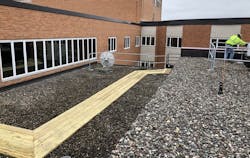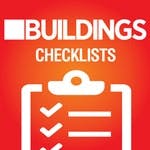Rooftop Management: Eliminate Injury Risk
For over 20 years, falls from heights have been a leading cause of serious injury and death in the workplace. Ladders, roofs, skylights, storage mezzanines, stairs, and loading dock platforms describe the most common places where people are seriously or fatally injured from falling.
For building owners and facility managers rooftop environments pose big risks. The Occupational Safety and Health Administration (OSHA) requires employers to identify and protect workers from fall hazards of 6 feet or more while performing construction activities and 4 feet or more while completing routine maintenance tasks.
Facility owners employing contractors to perform work on roofs share similar obligations through OSHA’s multi-employer authority. In these cases, the facility owner is viewed as the “controlling employer” and are subject to the same fines/citations received by the contractor.
[Read also: 6 Causes of Urban Heat Islands and 4 Ways to Offset Them]
An Ounce of Prevention
It’s obvious what the benefits of prevention are and that’s where the bulk of the effort and resources need to be placed. Just talk to any employer that’s gone through a workplace fatality and they openly admit that the human cost, and subsequent business costs, are not worth short-changing prevention.
The Occupational Safety and Health Administration (OSHA) requires employers to identify and protect workers from fall hazards of 6 feet or more while performing construction activities and 4 feet or more while completing routine maintenance tasks.
OSHA citations, increased insurance premiums, personal hardship, and a nightmare of litigation and publicity should be enough of a deterrent when accounting for safety in annual budgets.
Unprotected roof edges, hatchways, fixed ladders, and even skylights must be properly protected to ensure no one suffers a fall. While prevention seems as simple as “stay away from the roof edge” the risk remains in the form of satisfying OSHA requirements.
As challenging as it is to control our own behavior the risk compounds exponentially when contractors are allowed access to a roof to perform work.
“We understand it is our obligation to protect our employees, and contractors, and we choose guardrails as the best solution…minimal training, minimal upkeep, and equipment where workers can’t use it incorrectly.” - Director of Facilities, Allina Hospitals and Clinics
2 Common Rooftop Safety Systems
The solutions for preventing falls is straight forward and achieved through engineering and process controls. The idea is to make prevention as simple and as easy as possible so human error has the lowest chance of entering into the equation.
When proper equipment and processes are used they offer a one-two punch to ensure that when people go up they only come down when they want to. Employers have found that the use of both engineered fall protection systems and written protocols, such as a rooftop management plan, offer the greatest reduction of risk.
Let’s look at the pluses and minuses of the two most common engineered rooftop safety systems—personal fall protection and guardrails.
1. Personal Fall Protection Systems
Personal fall protection systems require workers to be tied or tethered through a combination of a body harness and a lifeline attached to a fixed engineered anchorage point on the roof. These systems are meant to either restrain the worker from getting to close to an edge/opening or stop them from falling to the ground should they go over the side.
[Related topic: How to Avoid Construction Liabilities]
Considerable training, inspection, and maintenance is associated with these systems. Often, suitable anchor points cannot be found and using the nearest ventilation pipe is not allowed. Portability and maneuverability of this equipment allows for fall protection in areas where a guardrail cannot be erected.
2. Guardrail Systems
Guardrail systems are commonly engineered out of steel and to OSHA specifications. They can be erected either temporarily or permanently around roof edges, hatchways, skylights or other areas where falls to a lower level exist.
Installation at the roof edge allows work to be freely performed at the edge and entirely within the guarded area without the use of other fall protection devices.
BUILDINGS Podcast
Carlisle Roofing Series #3: Alternative Attachment Methods
You don’t always need a bucket of adhesives to attach a single-ply roof. Carlisle’s Chad Buhrman, insulation product manager, and Alex Drescher, VacuSeal product manager, walk editor-in-chief Janelle Penny through the options. Listen here >>
5 Items for Your Rooftop Management Plan
Regardless of who or why a person goes up on a roof their activities need to be accounted for and controlled. Taking control of how the work on a roof is performed is a risk reduction practice.
A rooftop management plan establishes a process that controls rooftop activities by accounting for the following five things:
1. How access will be made—ladder, aerial lift, stairwell
2. The nature of the work to be performed, timeline and what equipment will be used
3. What fall protection systems will be used
4. Required training in fall protection systems, hazard recognition and granting access to only those that have been authorized
5. Describe what actions will be taken in the event of an emergency such as removing an injured person from the roof or someone dangling from the side
Case Study
The facility maintenance team at a large public-school district in Minnesota is responsible for a long list of building maintenance items requiring routine visits to rooftops.
Inspection or repair is necessary to equipment like roof drains, HVAC units, cameras, satellites, vents, fans, exhaust units, ladder access, roof hatches, etc., many of which are located near roof edges.
This situation presented fall risks to not only school district employees but also contractors that are frequently hired to perform repairs. The buildings lacked engineered and certified anchorage points for personal fall protection systems.
BUILDINGS Checklist
Preventative Maintenance Checklist
When you stay on top of upkeep, you avoid costly emergency repairs and equipment failures. Use this checklist to keep major building systems— HVAC, roofing, plumbing and lighting—in good working order. Get yours here >>
The school district was concerned about installing embedded roof anchors, penetrating the roof liner and water intrusion. A non-penetrating solution was requested that would not void the roof warranty or penetrate the building façade.
The system was constructed at the roof edge preserving the freedom of movement over the entire roof environment. Hatchway and skylight exposures were also addressed in the same fashion.
Based on these criteria the most appropriate solution was a guardrail system that offered fall protection directly at the point of access to the roof from a fixed exterior ladder. The guardrail system consisted of a combination of guardrail panels, weighted bases and spanners.
Injuries from falls often change lives and facility owners and managers have a responsibility to protect those performing work at heights including roofs. Injury prevention is achieved through the application of engineering and process controls.
This holistic approach provides effective risk management that only requires a commitment to the resources to make it happen. Requesting assistance from a third party safety consultant may be helpful when evaluating which fall protection solution is most appropriate for your needs.
About the Authors:
Dan Hannan, CSP Hilmerson Safety, has been a health and safety professional of 28 years serving predominately the construction industry. Mr. Hannan works closely with company leaders to advance safety program performance and recognize the prevention of injury as a core value. He can be reached at: [email protected].
Debra L. Hilmerson, President/CEO Hilmerson Safety, has been a health and safety professional for 30 years. Hilmerson Safety is a full-service safety product design and manufacturing company serving the construction, manufacturing, and oil and gas industries.
Two handpicked articles to read next:

